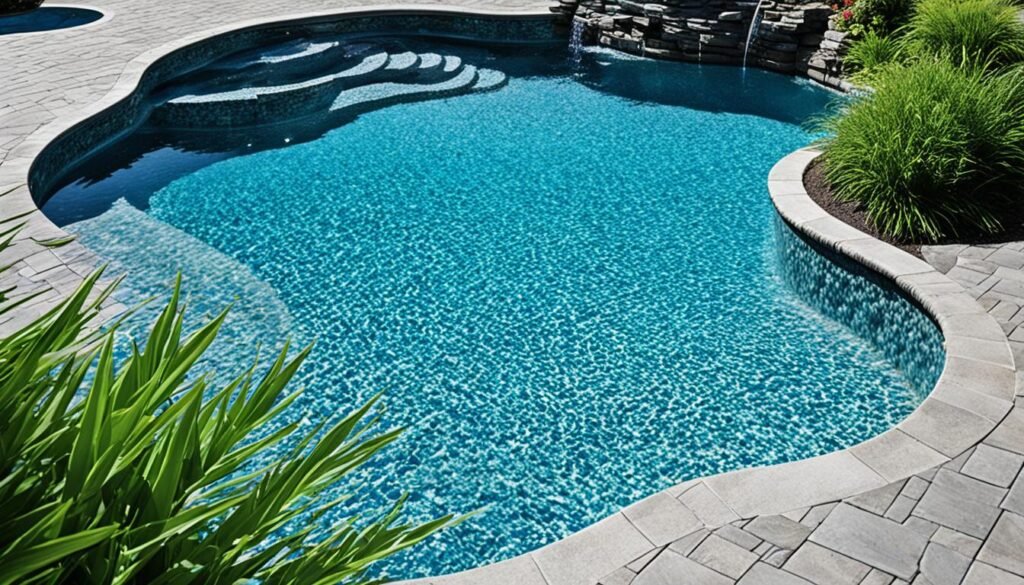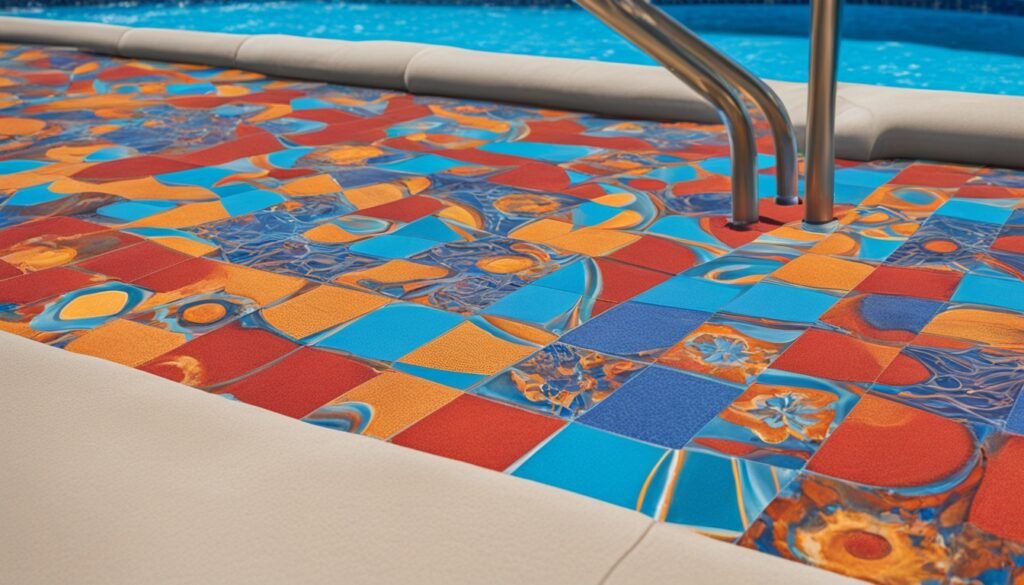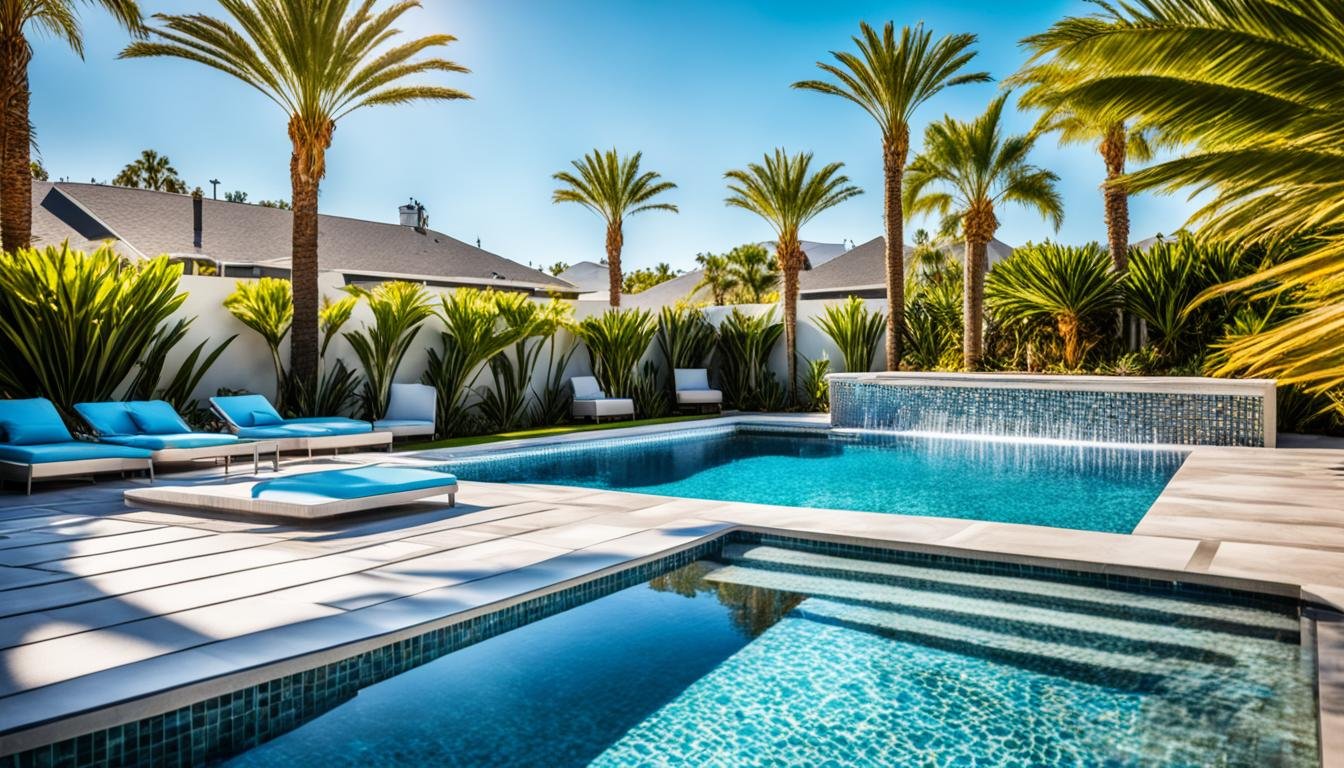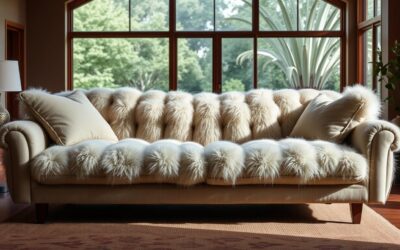Finding the right pool liner is key to making your backyard oasis perfect. It boosts the look and helps your pool last longer. With many choices in color, pattern, texture, and thickness, picking the right one can be tough. But, with some advice, you can easily pick a liner that fits your pool, yard, and style.
Key Takeaways
- Vinyl pool liners come in a range of thicknesses, with 20 mil and 30 mil being the most common1.
- Thicker liners offer greater durability and puncture resistance, lasting up to 16 years, compared to 8-10 years for thinner 20 mil liners1.
- Blue is the most popular color for pool liners, with varying shades offering different benefits like warmth retention and hiding dirt1.
- Textured pool liners provide enhanced safety with a non-slip grip, especially on steps and high-traffic areas1.
- Proper pool water chemistry and UV protection are crucial for maintaining the longevity and appearance of vinyl liners1.
Table of Contents
Understanding Pool Liners
Pool liners cover the floor and walls of a swimming pool. They keep the water in and make the pool look good. There are many types of liners, each with special features2.
What is a Pool Liner?
A pool liner is a strong, waterproof cover for the pool’s structure. It can be made of concrete, fiberglass, or vinyl. The liner stops water from leaking and keeps the pool safe2.
Types of Pool Liners
Pool liners come in three main types: overlap, beaded, and unibead. Overlap liners are the cheapest and easiest to put in. Beaded liners give a smooth look. Unibead liners mix both, with a special bead for the wall2.
- Overlap Liners: These liners have extra material that overlaps the walls for a tight seal.
- Beaded Liners: Beaded liners have a special bead that fits into the pool’s walls for a neat look.
- Unibead Liners: Unibead liners have a bead that attaches to the wall, combining the best of both types.
Vinyl liners are cheaper to install and replace than cement finishes. They can be replaced in a few hours with a skilled team3. Vinyl liners don’t change much with water chemistry, so they’re easier to maintain2.
“The Chemical Fabrics and Film Association (CFFA) sets standards for swimming pool liners. Common liners are 20 or 28 mil for homes, and 60 mil for big pools.”2
Color Considerations
Choosing the right color for your pool liner can change how your backyard looks and feels. Dark and light colors affect how much heat the pool absorbs and how well you can see debris. Let’s explore how dark and light colors work with the light around your pool.
Dark vs Light Colors
Darker colors like black or dark blue make the water warmer, which is great for cooler places or longer swimming seasons4. Light colors such as white or gray keep the water cooler, perfect for hot areas or summer4. Light-colored liners also make it easier to see debris, helping you clean the pool4. Darker liners, however, hide dirt better5.
Natural Lighting and Surroundings
The light around your pool affects its color. Light-colored liners reflect sunlight, which means less heat and less water loss, saving you money on bills4. They also make the pool safer by making it easier to see depth changes and prevent accidents4. Dark liners, on the other hand, hide dirt and imperfections, which might mean less cleaning5. But, they show wear and tear more, so they might need replacing sooner5.
Choosing a pool liner color is about looks and practicality. Whether you want a dramatic or a light look, the color affects your pool experience45.
Pattern Options
Choosing a pool liner can be exciting with its many designs. You can pick from classic to bold patterns6. There are different weights like 20 Mil, 27 Mil, and more6. You’ll find liners in patterns such as Blue Granite and Butterfly Effect Pearl6.
Consider a liner with a border that matches your pool area6. Tile heights vary from 6″ to 11″ across different patterns6. For the pool’s body, choose a solid color or a detailed design. The Pearlscape Collection offers unique patterns to change your pool’s look6.
Liners come in light, rich, and deep shades6. Floor names like Blue Slate offer various design options6. Shades range from light to dark, with options like Medium and Dark6. Some liners are Fully Embossed or have special features6.
Think about the look you want and how it fits with your outdoor space6. It’s wise to see a sample before ordering due to color variations6. All patterns are full print liners, no tile borders for some6. Liners work well with vinyl over step applications6.
With so many pool liner patterns, pool liner designs, and pool liner tiles to pick from, you can customize your pool easily. Whether you like a classic or modern style, there’s a custom pool liner pattern for you7. High-end liners include Grand Carnival and Skyline Mosaic Electric Gold at 36 Mil7. Common options are several patterns at 27 Mil7. Some companies offer fast replacement liners, shipping within 48 hours7.
Texture for Safety and Aesthetics
Texture is key for both safety and looks in pool liners. Textured8 vinyl liners make the surface non-slip, cutting down on slips and falls, especially on steps9. They have an embossed pattern that feels gentle underfoot, making swimming safe and comfy.
Textured Vinyl for Traction
Textured vinyl liners are a top pick for making pools safer. They look good and prevent accidents by giving a firm grip, especially on steps and ladders9. This is great for families with kids or older people, making swimming fun and secure.
All-Over Pool Textures
Some liners have texture all over, not just on the steps. These liners can look like gunite, sand, or tile patterns8. This full texture boosts safety and makes the pool look unique and appealing.

Choosing a textured liner, for steps or all over, brings clear safety and style benefits9. These liners offer a safe and cozy surface for swimmers. They also add beauty and match the pool’s decor and surroundings89.
Thickness and Durability
Thickness is key when picking a pool liner. They vary from 20 to 40 mil10. Thicker liners cost more but are worth it because they last longer and don’t leak as easily1011.
LinerWorld’s liners are 25 gauge for top-notch durability10. For most home pools, a 20 mil/25 gauge liner is best for regular use10. But, the best thickness depends on how you use your pool, where it’s located, and what you prefer10. Vinyl is popular for its toughness and flexibility, with sizes from 20 to 30 mil11.
Thicker liners protect against punctures from pets, branches, and glass11. Though they cost more, they’re often fixable, not replaceable11. Choosing the right liner thickness and durability is key for your pool.
Warranties on pool liners show their quality and long life10. You can also look at other materials like fiberglass and concrete for their own benefits11.
Think about the thickness and durability of pool liners to make a smart choice. This way, you get the best value for your pool money.
Liner Installation and Climate
Installing a pool liner is easier in warm, breezy weather. This is because thicker liners work better when they’re not stiff from the cold12. It’s smart to keep the liner in a warm spot for at least 72 hours before putting it in13.
Preparing for Installation
Getting ready is important for a smooth liner installation. Clean and smooth the pool surface well12. Also, check the liner box, label, and the liner itself before you start. This is because you’re fully responsible once water goes in12.
Installing the liner needs careful attention. Having 2 to 4 people helps with lining it up and attaching it right, as most mistakes happen here1213. Watch the filling process closely, every 20 minutes, until it’s half full to make sure it’s done right12.
Using a Vac/Blower 2HP 130 CFM helps during installation. Keep it running until there’s 6 inches of water in the shallow end13. Also, fill the pool when it’s sunny, and have someone check on it often12.
Think about the weather, prepare the pool well, and follow the right steps for installing a pool liner. This way, you’ll get a liner that lasts and makes your backyard more fun.
pool liner Maintenance
Keeping your pool liner in good shape is key to its long life and clear water. You need to balance the water chemistry and protect it from UV and chlorine damage. These steps are important14.
Balanced Water Chemistry: The Key to Liner Longevity
Right water chemistry is vital for your pool liner’s health and life. Vinyl liner pools are easier to maintain than concrete ones because they last longer and use new technology14. You should keep the pH, total alkalinity, free chlorine, calcium hardness, and stabilizer levels balanced. This prevents problems like calcium scaling, wrinkling, puckering, and early aging of the liner15. Make sure to dissolve pool chemicals well before adding them to avoid bleaching and damage to the liner14.
Safeguarding Against UV and Chlorine Damage
UV rays and too much chlorine can harm your pool liner. Using a pool cover to block UV rays and picking a liner with UV and chlorine protection helps it last longer14. Clean the waterline with a vinyl liner cleaner often to stop dirt and oil from causing stains and sun damage14.
By following these tips for maintaining your pool liner, you can keep your pool looking great and enjoy it for many years.
Coordinating with Surroundings
Choosing the right pool liner is key to making your backyard look great. Think about how it matches the pool deck and landscaping16. A liner that blends well with these elements can make your pool area look better16. Don’t forget to consider how natural light and shadows will affect your pool liner choice16.
Complementing Deck and Landscaping
Your pool liner’s color and style should match your deck and landscaping17. Avoid using regular paint on concrete, as it can look bad16. Instead, pick a liner that matches the colors of your pool equipment for a unified look16.
For a smooth look, consider a pebble print liner that looks like Gunite pools17. Placing skimmer boxes and lights carefully can reduce distractions. Using materials like travertine or bluestone can also add to the look of your concrete pool16.

To make your pool area look better, add decorative items like floating swans or peacocks16. Choose liner colors that match your decor and furniture for a cohesive look16. If your pool isn’t the best, focus on improving the landscaping and furniture around it16.
Timing is important for outdoor projects like landscaping or installing a pool, especially in cold areas16.
| Tile Options | Water Color Impact | Color Categories |
|---|---|---|
| The article highlights the wide variety of tile patterns available for pool liners, emphasizing contrasting colors like in Baja and Cheyenne, less contrast in Key West and Paintrock, and blending patterns like Port Royal and Ocean Wave to suit different preferences, indicating a diversity in choices for pool owners17. | Factors influencing the water color of pools are discussed, such as the presence of surrounding greenery affecting aquamarine hues and the depth of the pool influencing color perception, underscoring the importance of considering design elements beyond just the liner pattern17. | Pool liner patterns are categorized into Deep Blue, Light Blue, and Aqua options, each creating distinct water colors, with Deep Blue being the most popular, Light Blue offering lighter shades, and Aqua providing a turquoise or cyan blue color, showcasing a range of preferences in water aesthetics17. |
Customizing vinyl liners lets you change patterns, cover stairs and benches, and add unique touches17. This gives pool owners a chance to make their pool their own17.
Liner thickness isn’t the main factor in how long a liner lasts17. The real factors are the material quality, fit, and protection from chemicals, UV rays, and fading17.
By carefully coordinating your pool liner with the surrounding elements of your backyard, you can create a seamless and visually appealing poolscape that enhances the overall aesthetic of your outdoor living space.161718
Customization Options
Pools can be customized in many ways. Vinyl liners can match various pool features like stairs, benches, and tanning ledges19. This makes your pool look seamless and matches your design20.
You can choose from many colors, patterns, thicknesses, and textures for your pool liner20. This lets you make a pool that’s unique and fits your backyard20. Vinyl liner pools are made to be high quality and affordable20.
Covering Built-In Features
Polymer steps are popular for their cost and customization19. Vinyl-over-steel steps are also a top choice for their durability and fit19. Tanning ledges are now a favorite for adding beauty to your pool19.
Customizing your vinyl liner pool isn’t just about the liner. You can pick from different decking materials like brick, wood, and stone19. You can also customize your pool’s equipment, like pumps and filters, to meet your needs19.
Vinyl liner pools are the most budget-friendly inground pool option21. They’re also quicker to install than other pools20. With so many customization options, you can make a pool that’s truly yours and fits your backyard201921.
Lifespan and Warranties
Pool liners are key to keeping your pool safe and looking great. They usually last 8 to 12 years, with some lasting over 15 years22. Above-ground liners might not last as long, usually 6 to 10 years22. Saltwater pools have liners that last as long as chlorinated ones, 8 to 12 years22.
Pool liner manufacturers offer warranties, often up to 20 to 25 years22. These warranties give you peace of mind and protect against early wear and tear. But, remember, these warranties can decrease in coverage over time23.
Look out for signs like cracks, tears, or stains that mean it’s time for a new liner22. The best time to switch liners is in spring or fall, so you don’t miss out on summer fun22.
How often you use your pool, keeping the water balanced, and not draining it fully can affect the liner’s life22. Taking good care of the liner’s top edge can also make it last longer22.
| Liner Type | Average Lifespan | Warranty Duration |
|---|---|---|
| Inground Pool Liners | 5-9 years23 | 20-25 years23 |
| Above-Ground Pool Liners | 6-10 years23 | 20-25 years23 |
Keeping your pool water balanced is key to making your vinyl liner last longer24. Follow the manufacturer’s advice and fix problems fast to keep your liner in top shape and your warranty valid23.

Choosing the Right Pool Liner
Finding the perfect pool liner can seem tough, but it’s key to making your backyard look great. You’ll find many options, like color, pattern, texture, and thickness. Think about what’s best for your pool, budget, and style25.
Pool liners usually last 10 to 15 years with good care25. Thicker liners are stronger and less likely to get punctured, but they cost more25. Darker liners fade faster because of sun and chlorine damage25. Using a cover can make your liner last longer by protecting it from the sun25.
For above ground pools, you can choose beaded or overlap liners, with each being popular26. Unibead liners are easy to put in, which might make them more popular26. Many people call for help when buying liners, showing the need for guidance26. It’s important to get the right size and type to avoid returns26. You can also switch from an overlap to a beaded liner, showing a desire for flexibility26.
Knowing the good and bad of each liner type helps you choose the best for your pool. Whether you want it for its strength, color, or fit, there’s a liner out there for you.
| Liner Type | Lifespan | Durability | Cost | Maintenance |
|---|---|---|---|---|
| Vinyl | 10-15 years | Moderate | Moderate | Regular cleaning and chemical balance |
| Fiberglass | 15-20 years | High | High | Minimal maintenance |
| Polyethylene | 10-15 years | Moderate | Low | Regular cleaning and chemical balance |
“The right pool liner can transform your backyard into a true oasis, so it’s worth the time to find the perfect fit.”
Conclusion
Choosing the right pool liner is a big deal. It’s all about picking the right color, pattern, texture, and durability. Each factor is key to making your pool a true reflection of your style27.
Buying a top-quality pool liner from a trusted brand like Pioneer Family Pools is smart. They offer up to 25-year warranties27. This means my pool will look great and last a long time. Their custom measurement and installation services27 ensure a perfect fit, avoiding early wear and damage28.
Next, I’ll keep up with water chemistry and check my pool often27. Using things like liner pads and covers will also help my liner last longer28. By doing these things, I’ll keep my pool looking great and ready for fun with my family and friends29.






0 Comments